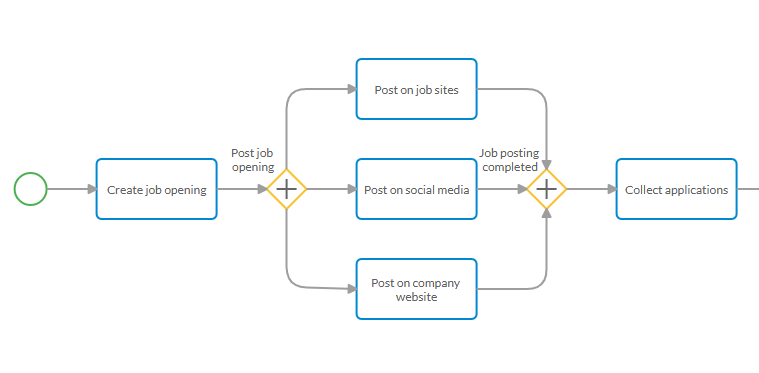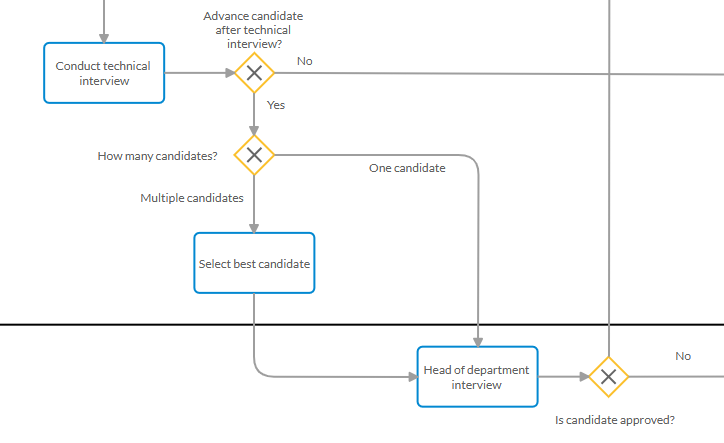Gateways in simulation
Gateways control the flow of a process by determining how and when paths diverge or converge. They’re used to model decisions, parallel actions, and outcomes that depend on conditions or probability.
In the hiring process, gateways help simulate different candidate outcomes — like whether to move forward with an applicant, which path to follow based on interview results, or when to finalize an offer.
We’ll look at the two types of gateways used in this process: parallel gateways and exclusive gateways.
-
Parallel gateways are used to run tasks at the same time, for example posting a job to multiple channels.
-
Exclusive gateways are used to make decisions based on probabilities or conditions, for example whether a candidate is shortlisted or not.
In BPMN, gateways mark where a decision occurs, while the outgoing sequence flows define how the decision is made. You configure probabilities or conditions on those sequence flows, keeping the model flexible and easy to maintain as decision criteria evolve.
Parallel gateways
Parallel gateways are used to run multiple paths at the same time. In this process, a parallel gateway splits the flow to simulate posting the job opening across multiple channels — job sites, social media, and the company website — in parallel.
Parallel gateways can also be used to join multiple paths, waiting for all of them to complete before continuing.

You don’t need to configure parallel gateways for simulation. Once added to the diagram, they automatically allow all paths to proceed or rejoin as defined.
Exclusive gateways
Exclusive gateways model decision points in the process. Only one path is taken, based on a defined rule.
In this hiring scenario, exclusive gateways control decisions such as whether to advance a candidate, which interview stage to proceed to, and whether to make or revise a job offer.

In simulations, probabilities and conditions are configured directly on the outgoing sequence flows from the exclusive gateway. While the gateway determines where the decision point occurs, it’s the sequence flows that define how the decision is made.
Each outgoing sequence flow can either have a condition that evaluates to true or a probability assigned to it.
You can’t set both a condition and a probability on the same sequence flow — you’ll need to choose one or the other for each flow.
Gateways in this process
The hiring process template already includes these gateway configurations, so you can see how each type is set up without having to configure them yourself.
| Gateway | Type | Configuration | Description |
|---|---|---|---|
| Post job opening | Parallel | None | Run job postings in parallel. |
| Job posting completed | Parallel | None | Indicates that all job postings have been completed. |
| Are there shortlisted candidates? | Exclusive | Probability | Checks if any candidates were shortlisted. |
| Advance candidate after first interview? | Exclusive | Probability | Models likelihood of candidate progressing to the technical interview. |
| Advance candidate after technical interview? | Exclusive | Probability | Models likelihood of candidate progressing to head of department interview. |
| How many candidates? | Exclusive | Condition | Evaluates candidate count to branch accordingly. |
| Is candidate approved? | Exclusive | Probability | Checks if a candidate is approved for hire. |
| Is offer accepted? | Exclusive | Probability | Determines if candidate accepts the offer. |
| Prepare revised offer? | Exclusive | Condition | Chooses revised offer path based on value. |